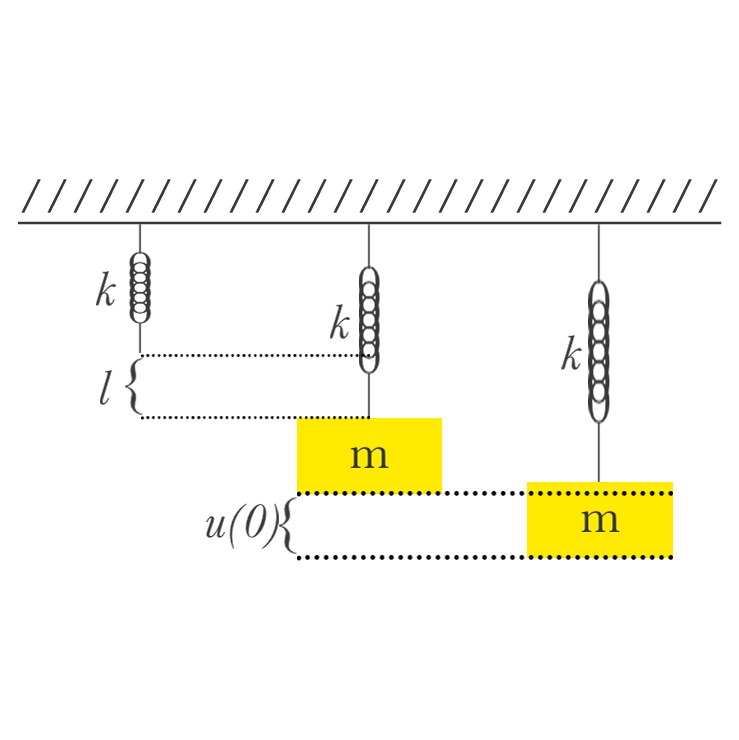IZTECH Math255 Notes p3
By E. Z.
Constant Coefficient Homogenous Eq.
\(\ ay''+by'+cy=0 ⇒ y''+\frac{b}{a}y'+\frac{c}{a}y=0 \)
\(\ p(x)=\frac{b}{a} , q(x)=\frac{c}{a} \)
So that 𝓅 and 𝓆 are continous functions on real line, then there exists a unique solution to the IVP: \(\ ay''+by'+cy=0, y(x_0)=y_0, y'(x_0)=y_1 \)
\(\ y=e^{rx} ⇒ e^{rx}[ar^2+br+c]=0 \)
Real and distinct roots
\(\ y_1 \) and \(\ y_2 \) are linearly independent
Real and repeated roots
Complex conjugate roots
\(\ y=c_1e^{αx}cos(βx)+c_2e^{αx}sin(βx) \)
Complex Conjugate Roots for Characteristic Eq.
as →
> 0
= 0
< 0
Mechanical Vibrations
Differential Model

\(\ \vec{F}_{net}=\vec{F}_{gravity}+\vec{F}_{spring}+\vec{F}_{damping} \)
\(\ \vec{F}_{gravity}=m\vec{g}, \vec{F}_{spring}=-k \vec{x}(t), \vec{F}_{damping}=-b \vec{v}(t), \vec{F}_{net}=m \vec{a}(t) \)
\(\\ 0=mu''+ bu' + ku \)
where is mass, is stiffness of spring and is damping coefficient
if it is called to be undamped
for:
\(\\ \small 0=mu''+ bu' + ku \)
is proportional to periodity of motion
is inversely proportional to periodity of motion
From characteristic eq.: \(\ r_{1,2}= \frac{-b \pm \sqrt{b^2-4km}}{2m} \)
if \(\ b^2-4km \) > 0 → overdamped oscillation
if \(\ b^2-4km \) = 0 → critically damped oscillation
if \(\ b^2-4km \) > 0 → underdamped oscillation
Constant Coefficient Non-homogenous Eq.
\(\ y''+p(x)y'+q(x)y=f(x), y(x_0)=y_a, y'(x_0)=y_b \)
Method of Undetermined Coefficients
This method is based on initial guess of dependent variable based on structer of the DE.
\(\ r_{1,2}=-2 ±i ⇒ α=-2 , β=1 \)
\(\ y_h=e^{-2x}(c_1 cos (x)+c_2sin(x)) \)
\(\ y_p=Ax^2+Bx+C \) from putting it into DE:
\(\ (5A)x^2 +(8A+5B)x + (2A+4B+5C)=x^2-1 \)
\(\ \begin{bmatrix} 5, 0, 0 \\8, 5, 0 \\2, 4, 5 \end{bmatrix} \begin{bmatrix} A\\B\\C \end{bmatrix}= \begin{bmatrix} 1\\ 0\\-1 \end{bmatrix} \)
\(\ y_g=y_p+y_h \)
| Exponential | Exponential with coefficient and same x coefficient |
| Polinomial | Polinomial of the same degree with unknown coefficients |
| Trigonometric | Linear Combinations of trigonometric functions with unknown coefficients |
for such 𝒻 containing their multiplications, 𝓍 is multiplication of them.
Variation of Parameters
It is a solution method for non-homogenous DE's. It is harder to apply than Undetermined Coefficients Method, but it does not requires any assumption and works for greater range of DE's including ones can be solved using undetermined coefficients method.
It is hard to guess a particular solution for a t using unknown coefficients method.
\(\ \small y_h=c_1y_1(x)+c_2y_2(x) \) and \(\ \small y_p=u_1(x)y_1(x)+u_2(x)y_2(x) \)
\(\ \small u_1= ∫ - \frac{f(x).y_2}{a.W(y_1,y_2)} dx \) and \(\ \small u_2= ∫ \frac{f(x).y_1}{a.W(y_1,y_2)} dx \)
Proof is left as an exercise for the reader.
characteristic equation is: \(\ r^2+16=0, α=0, β=4 \)
\(\ y_h=c_1cos(4x)+c_2sin(4x) \), \(\ y_p= \frac{cos(4x)ln(cos(4x))}{16}+\frac{sin(4x)x}{4} \)
\(\ y_g=c_1cos(4x)+c_2sin(4x)+\frac{cos(4x)ln(cos(4x))}{16}+\frac{sin(4x)x}{4} \)